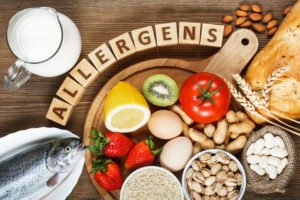About one in every 20 children has a food allergy
By Eva Briggs
 Kids aren’t born with the allergies. Not even if a parent has food allergies and regardless of what the mother ate during her pregnancy.
Kids aren’t born with the allergies. Not even if a parent has food allergies and regardless of what the mother ate during her pregnancy.
The tendency to develop allergies may be inherited. But a specific allergy requires exposure to the offending agent to develop. Usually the sensitizing exposure involves eating the offending food. In some cases, the initial exposure is via the skin.
Diagnosing food allergy begins with the history. Food allergy symptoms start soon after the food was eaten — in minutes to as long as four hours. Symptoms that occur the day after eating a food are not from an allergy to that food.
The following foods are the culprit in the vast majority of cases: milk, eggs, tree nuts (walnuts, pecans, almonds), fish, shellfish or legumes (soy, peanuts).
The food might be hidden in as an ingredient in a baked good or salad. Typical allergy symptoms are hives, trouble breathing, lightheadedness or vomiting.
To confirm a suspicious history, allergists check skin tests or blood tests. It’s wise to test only for the suspected food and perhaps closely related foods. Complete food panel tests are unnecessary and potentially misleading.
Blood test levels may not correlate with the severity of an allergic reaction. Usually if a child has a certain type of reaction, subsequent reactions will be the same. But not always. Families need to prepare for unanticipated severe reactions.
Start with avoidance. Read ingredient labels and menus carefully. Children with food allergies should have access to an epinephrine autoinjector, such as an EpiPen. Treat mild reactions with an antihistamine. Diphenhydramine (Benadryl) has been the mainstay, but cetirizine (Zyrtec) may be a better choice. It starts working as quickly as diphenhydramine, lasts longer, and causes less drowsiness.
For severe allergic reactions, such as any respiratory symptoms, dizziness or vomiting more than once, administer epinephrine and go to the emergency room. The reason is that the allergic reaction might outlast the epinephrine and recur when epinephrine wears off. If that happens, the emergency room can provide further treatment. Epinephrine side effects include shakiness and rapid heartbeat.
About 75% of egg or milk allergic children tolerate them in baked goods. If uncertain, an allergist can challenge under observation in the office. If a child can safely eat milk or eggs cooked in food, they have more food choices. Most children allergic to eggs and milk outgrow these allergies during childhood.
Doctors once thought children never outgrew peanut, tree nut or shellfish allergies. We’ve learned that as many as 20% of children do outgrow these allergies.
An allergist will ask about accidental exposures and reactions during yearly follow-up visits. The allergist may then repeat the skin test. If there is no history of reaction and levels of the blood test have fallen, the doctor may perform a food challenge in the office or recommend a Sublingual Immunotherapy Training.
Food reaction
Certain fruits and vegetables cause mouth itching in some pollen-allergic people. This is called oral allergy syndrome or pollen food allergy syndrome. Substances in these fruits and vegetables cross-react with proteins found in the pollen. It does not progress to anything dangerous.
Another food-related reaction is eosinophilic esophagitis (EOE). A type of white blood cells, eosinophils, inflames the esophagus. It starts at any age. Infants and toddlers experience difficulty feeding. School-age children vomit and have abdominal pain. Teenagers report trouble swallowing and food getting stuck. The diagnosis requires upper endoscopy, looking into the esophagus with a lighted tube, and obtaining biopsy samples. There is no easy test to determine which food is causing the problem. Treatment starts with an acid blocking medicine. Another treatment uses a thick formulation of oral steroids to coat the esophagus. Eliminating various foods and checking the response by repeating endoscopies is another option, but this might require six to 10 endoscopies.
Another food reaction is food protein enteropathic syndrome. The onset is hours after the food is ingested with vomiting accompanied by lethargy. There is no specific test. Fortunately, most kids outgrow this. Ondansetron (Zofran) can help with vomiting.
We used to think you could reduce the chance developing a food allergy by delaying common allergy-provoking foods in children at high risk. We’ve learned the opposite is true. Exposing children to peanut protein starting at age 4-6 months reduces the chance of developing peanut allergy. Of course, you can’t feed infants whole peanuts. But thinned peanut butter, or peanut containing products designed for children work fine.
Eva Briggs is a medical doctor who works at two urgent care centers in the Syracuse region.

